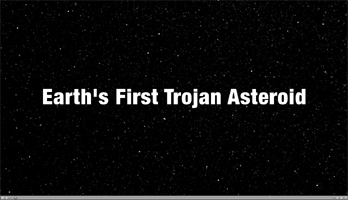Trojan Asteroid Shares Orbit with Earth (Artist Animation)

Earth's First Trojan Asteroid
Click on the image for the animation
This animation illustrates the orbit of 2010 TK7 (green dots), the first known Earth Trojan asteroid, discovered by NEOWISE, the asteroid-hunting portion of NASA's WISE mission. Trojans are asteroids that share an orbit with a planet, circling around the sun in front of or behind the planet. They circle around stable gravity wells, called Lagrange points, which circle the sun like Earth does.
The movie follows Earth as it travels along its orbit (blue dots) around the sun, so Earth remains at the front of our view. The various objects are not drawn to scale.
Asteroid 2010 TK7 has an extreme orbit that takes the asteroid far above and below the plane of Earth's orbit. The motion above and below the plane is referred to as an epicycle. In addition, the asteroid moves within the plane of Earth's orbit in what is called libration, circling horizontally around its stable point every 395 years.
Typically, Trojan asteroids, for example those that orbit with Jupiter, don't travel so far from the Lagrange points. They stay mostly near these points, located where the angle between the sun and Earth is 60 degrees. Asteroids near a comparable position with respect to Earth would be very difficult to see, because they would appear near the sun from our point of view.
WISE was able to spot 2010 TK7 because of its eccentric orbit, which takes it as far as 90 degrees away from the sun. WISE surveyed the whole sky from a polar orbit, so it had the perfect seat to find 2010 TK7. Follow-up observations with the Canada-France-Hawaii Telescope on Mauna Kea, Hawaii, helped confirm the object's Trojan nature.
The clock at upper left shows how the orbit changes over time. The asteroid's orbit is well defined and for at least the next 100 years, it will not come closer to Earth than 15 million miles (24 million kilometers).
JPL manages the Wide-field Infrared Survey Explorer for NASA's Science Mission Directorate, Washington. The principal investigator, Edward Wright, is at UCLA. The mission was competitively selected under NASA's Explorers Program managed by the Goddard Space Flight Center, Greenbelt, Md. The science instrument was built by the Space Dynamics Laboratory, Logan, Utah, and the spacecraft was built by Ball Aerospace & Technologies Corp., Boulder, Colo. Science operations and data processing take place at the Infrared Processing and Analysis Center at the California Institute of Technology in Pasadena. Caltech manages JPL for NASA.
More information is online at http://www.nasa.gov/wise and http://wise.astro.ucla.edu.
